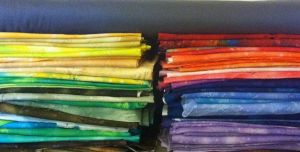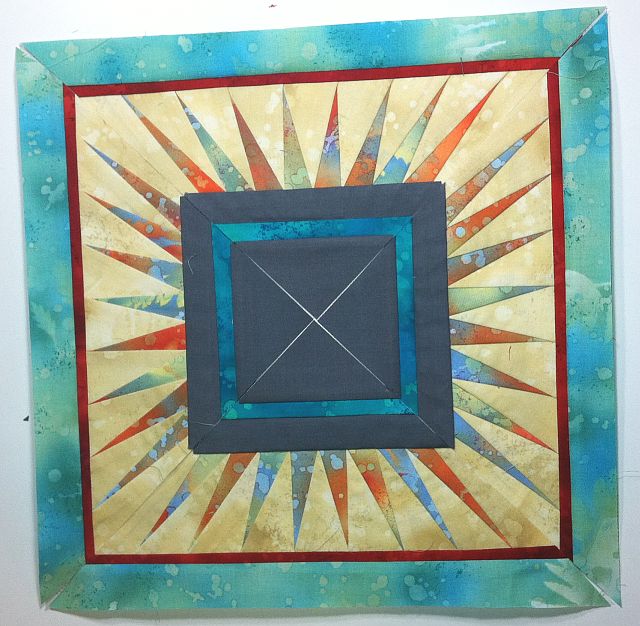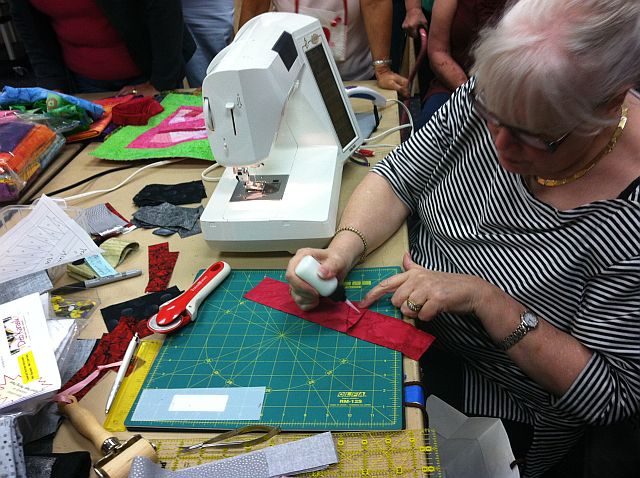 This is a Christmas Wreath quilt I designed and made from paper-pieced Log Cabin blocks.
This is a Christmas Wreath quilt I designed and made from paper-pieced Log Cabin blocks.
Since I can’t make anything anymore without feeling the need to write a tutorial for it, here you go:
I will demo making the log cabin blocks today. Part 2 covers completing the top and machine quilting.
The finished block size is 3″. The finished mini quilt (or table topper or pillow) is 18″ x 18.”
Step 1 – Gather Your tools and supplies. These are not a necessity, but as with any project, they make the job easier!
- Rotary Cutter
- Wooden Seam Roller for pressing
- Add a Quarter Ruler for neatly trimming while piecing
- A straight edge surface such as a postcard or piece of template plastic
- Vellum Tracing Paper to print the foundations on
- 1/2 yard of red fabric for centers, borders and binding (or scraps to equal that much)
- 1/4 yard of cream to tan fabric for light half of log cabin blocks (or scraps)
- 1/2 yard total of assorted green fabric scraps for log wreaths and border
- FQ of green for outer border
- Size 90 sewing needles for sewing through paper foundations
- Small scissor snips for trimming
- Cotton Thread for piecing
- Your choice of decorative thread for machine quilting
Step 2 – Cutting all the logs. I prefer to have everything cut out before I begin my sewing. The pieces are cut bigger and will be trimmed later. Although there are 4 sizes of light logs and 4 sizes of dark logs, I cut only 2 sizes for each. It wastes a tiny bit more fabric, but it’s easier to keep things organized, especially if I change my mind on fabric placement.
A little note on cutting pieces to fit – measure the finished size of your pieces and add 3/4 inch to this measurement (more if working with triangles). The units used for paper piecing have the extra 3/4 inch added in already.
Fabric cuts are based on 20-22″ long strips for working with fat quarters.
From the red fabric cut (if you cut very carefully you can get it all from just one fq):
- 16 – 1.75″ squares for centers
- 4 – 1.25 ” x 16″ strips for inner borders (to trim down later)
- 4 – 2 .25″ strips for binding (2 strips if using 42″ wide fabric)
From assorted white, cream, or tan scraps, cut 10 – 1.25″ wide 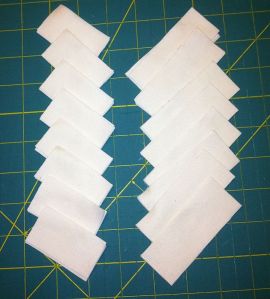 strips. Cross-cut into:
strips. Cross-cut into:
- 32 – 1.25″ x 2.25″ rectangles
- 32 – 1.25 x 3.25″ rectangles
From assorted green scraps, cut 12 – 1.25″ wide strips. Cross-cut into: 
- 32 – 1.25″ x 2.75″ rectangles
- 32 – 1.25″ x 3.75″ rectangles
From green border fabric, cut 4 – 2.25″ x 22″ strips (trim later)
Step 3 – Printing the Paper Foundations
You can download the paper pieced log cabin block pattern by clicking the image below. There are 4 per page, so you would need to print 4 pages for a total of 16 blocks. Be sure to set your printer to print the PDF at actual size, not print to fit.

You can print on copy paper but it is much easier to see what you are doing if you use see-through paper (vellum) instead. Cut apart your paper foundations leaving a seam allowance all around. It is printed in grey-scale so you can tell which side of the block is light and which is dark. The blocks are printed as a mirror image for this technique.
Step 4 – Sewing the Paper Pieced Log Cabins
There are a lot of pictures for this next section so I have shrunk them down in order. Just click on any picture to enlarge so you can see the details.
Line up your red square so that the BACK of the fabric touches the BACK of the paper. (Kind of tricky with solids – I know!) With right sides together, line up your first short white log on top of the red square, with about 1/4 inch overlapping your sewing line.
This first two pictures show the back side. You will be sewing from the front.
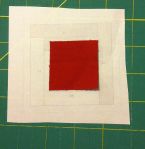


You can see a shadow where the fabric is sticking out far enough for the seam allowance.
Remember to start and end 1/8 to 1/4 inch before and after the line. Use a smaller stitch length and a larger needle. Sew on the line between A1 and A2.




Remove the block from the machine and clip threads. Use a wooden seam roller to press the newly sewn piece to the side. Flip the block back over to the front and using a straight edge (like a business card), fold over the paper on the next sewing line (between A1 & A3).




The excess seam will be exposed. (You may need to tug the fabric from the paper a bit to get it to lie flat.) To trim it neatly, use the add-a-quarter ruler to create a ridge on top of your block, paper, and straight edge. Trim off the excess. Flip the block over and add your next light log along the newly trimmed edge. Sewing on the printed side, sew the next seam.
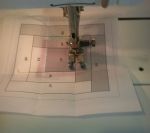
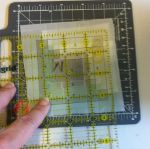
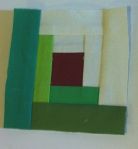 Continue sewing in this manner until all of your logs have been added. Remember to Sew, then Press, then Trim each seam.
Continue sewing in this manner until all of your logs have been added. Remember to Sew, then Press, then Trim each seam.
Once the block is complete you can trim off the excess leaving 1/4″ seam allowances.
Make your first block completely to test your process. Once you are satisfied with the results, Repeat to make a total of 16 blocks. You can sew all of the same steps at the same time to speed up the process. When you are done with the blocks, you may remove all the foundations, or keep them on until your complete your top.

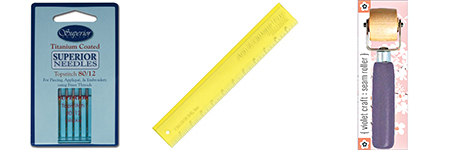










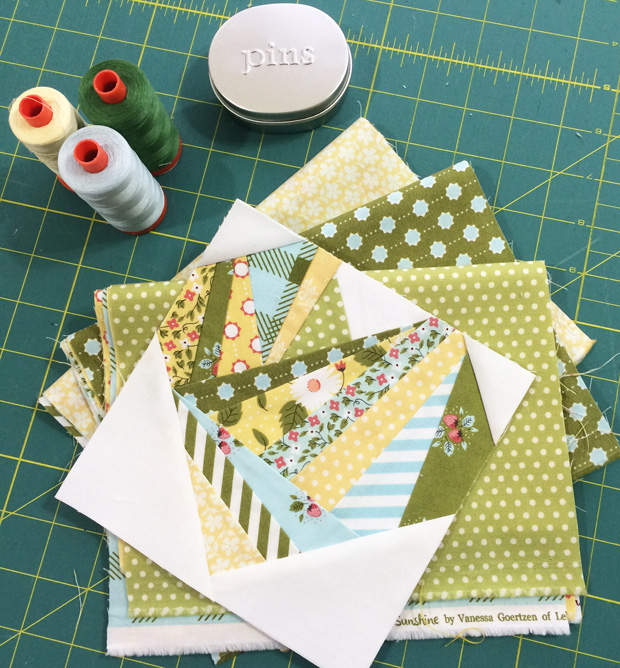



















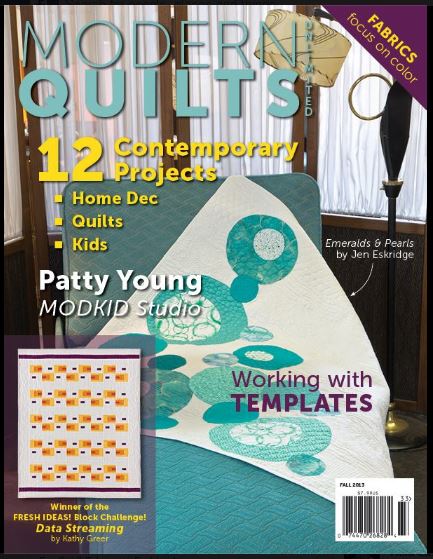






 This is a Christmas Wreath quilt I designed and made from paper-pieced Log Cabin blocks.
This is a Christmas Wreath quilt I designed and made from paper-pieced Log Cabin blocks.
 strips. Cross-cut into:
strips. Cross-cut into:















